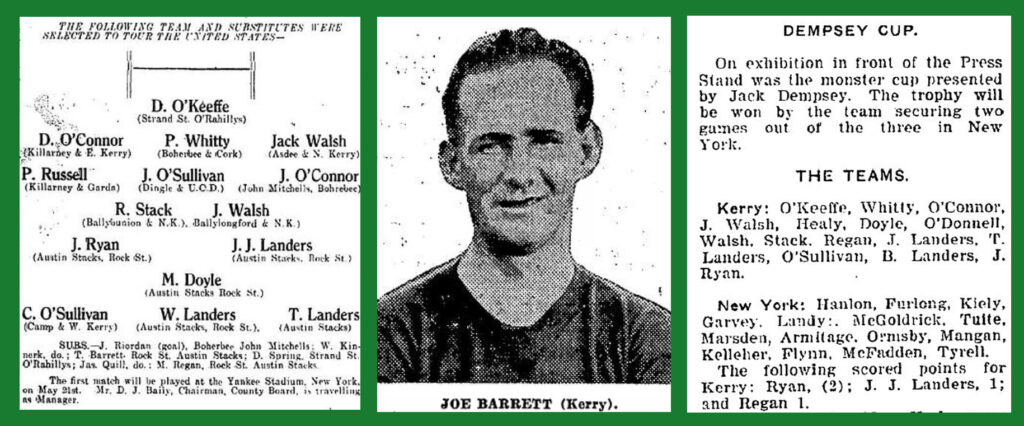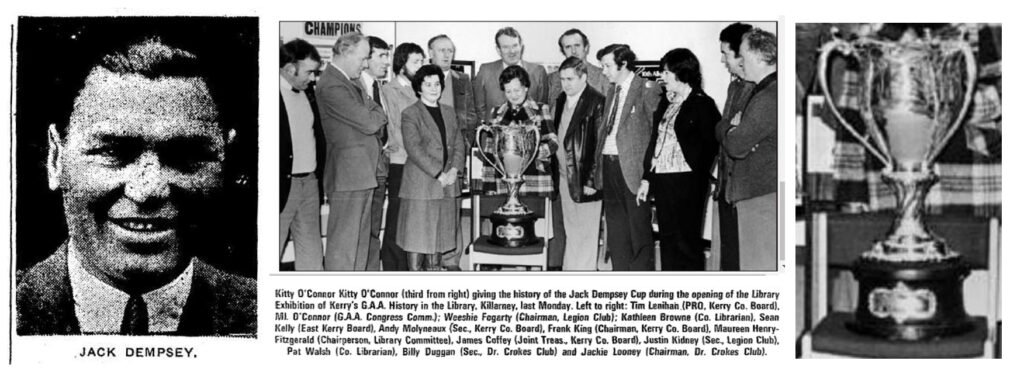In April 1924, legislation was passed by the Dáil to establish the new court system for the Irish Free State.[1] At this historic juncture, amid a sea of change, Kerrymen in New York subscribed £58 towards a fund for the training of the Kerry football team.[2]
A great effort followed to popularise Gaelic football in America. In 1926, D J Baily, Honorary Secretary of the Kerry County Board, received an invitation from a Tarbert man, Tom O’Donnell, Captain of the Kerry Football Team of Chicago, to a challenge game at Gaelic Park.[3]
The following year, Kerry fared badly in a game at the Polo grounds, New York, at which 40,000 spectators were present. The final score was three goals eleven points for New York to one goal seven points for Kerry. Mr R Fitzgerald, in charge of the Kerry team, said, ‘The game was a very poor sample of Gaelic football in a field too small for any real evolution. Kerry never tried to play, and say they never mean to play what is called Celtic Park football again.’[4]
There was no tour in 1928 or, it seems, in 1929.[5] In 1930, the Kerry Co Board of the GAA issued notice that it would withdraw sanction of an American tour of the Kerry team ‘unless a benefit game is arranged in New York, the proceeds to be turned over for the upkeep of the Tralee Gaelic grounds.’[6]
In 1931, the Hamburg-American Line announced that the Kerry football team would be sailing to America from Cobh on the St Louis on 4 May 1931 to play six games with selected GAA teams in America, namely New York, Boston, Chicago, Cleveland, Philadelphia and San Francisco.[7]
The tour was sponsored by the McGovern Brothers’ Association of Brooklyn, New York who also sponsored the Tralee sportsfield. The aim of the tour was ‘to help the games of the Irish race in America.’[8] The players selected included Castleisland’s Con Greany.[9]
In 1932, the American Team visited Ireland for the Eucharistic Congress. John Joe Sheehy, Chairman of the Tralee Sportsfield Committee, stated at their AGM that a tournament was planned for 1st May, and that the President of the Central Council had agreed to open the new stand.[10]
The year 1933 was to be a very successful one for the Kerry Team in America under captain Joe Barrett.[11]

The team beat New York at the Yankee Stadium, the home ground of the New York Baseball Club, by 15 points to 7 points before 18,000 spectators and won the coveted Jack Dempsey Cup. The final score was Kerry 4.3, New York 0.7.[12]

In an interview, Mr F J O’Keeffe, General Secretary of the GAA who accompanied the team, said the tour was a great success and everywhere they went they had a cordial reception. He mentioned the places they played and said the games played in New York were the finest and the hardest fought he had seen for a long time.[13]
In July, the triumphant Kerry team arrived in Cobh on the liner Columbus clutching the Jack Dempsey Cup, which had been presented by Jack Dempsey himself.[14] They also brought back the Springfield (Massachusetts) Cup, the Chicago Cup and the New Jersey Cup.[15]
The cups were later on display in Tralee:
Four beautiful silver cups won by the Kerry Football Team during their American Tour are now on view in Mr Con Clifford’s window at Castle Street.[16]
In March 1981, the Jack Dempsey Cup formed part of an exhibition in Killarney library at which time it was valued at £3,000.

____________________
[1] https://www.dublincastle.ie/11-june-1924-opening-irelands-law-courts/ [2] Evening Herald, 9 June 1924. ‘Mr Maurice Rohan, in forwarding the money, expressed the hope that Kerry would once more win All Ireland football honours.’ [3] Liberator Tralee, 3 July 1926. [4] Irish Independent, 30 May 1927. [5] The Central Council GAA did not sanction an American tour in 1928, ‘that having regard to the decision of Congress instructing the Central Council to consider the question of the organisation of the Gaelic Athletic Association in USA, the Council refuse to grant permission to any team to travel to USA in the meantime’ (Connacht Tribune, 19 May 1928). [6] Nationalist and Munster Advertiser, 21 May 1930. ‘This means that unless a third match is arranged in New York the tour is officially declared off.’ The following suggests it may have gone ahead: ‘For some of the Kerry players it was the second world’s championship fight they witnessed, the other being the Sharkey-Dempsey fight in 1930’ (Irish Press, 7 July 1933). [7] The team would return home on the liner Milwaukee to Cove in June 1931. [8] The invitation was made in 1930 by T F Delaney, Chairman, and P J Grimes, secretary of the Eastern Division GAA, New York. [9] The players were John Joe Sheehy (captain), Tralee; John Riordan, Tralee; Joseph Barrett, Tralee; Joseph Sullivan, Dublin University; Timothy O’Donnell, Camp; Denis O’Connor, Killarney; Jack Walsh, Croughdarrig, Asdee; Paul Russell, Civic Guard stationed in Monaghan; Con Brosnan, Newtownsandes; Robert Stack, Doon, Ballybunion; John Ryan, Tralee; Michael Doyle, Tralee, Ned Fitzgerald, St Enda’s College, Rathfarnham; Edward Sweeney, Dublin; John Joe Landers, Tralee; Tim Landers, Tralee; Con Greany, Castleisland; Dan O’Keeffe, Tralee; Patrick Whitty, Tralee; John Flavin, Newtownsandes; Tom Barrett, Tralee; Jack McCarthy, secretary, Kerry Co Board, Tralee. [10] Kerry Champion, 23 April 1932. A report of the AGM of the Tralee Sportsfield Committee showed a loan for purchase of field £396 15s 3d. [11] ‘Joe Barrett, who did not travel last time, is designated captain this year. Three Landers brothers, one of them with long New York experience, are included, and a few more will have seen the Statue of Liberty before on a same mission’ (Irish Press, 4 April 1933). ‘Kerry Co Board have selected M Healy (Austin Stacks) and Con Gainey (John Mitchels) to replace D O’Connor and Joe O’Sullivan on the Kerry USA team (May 1933). [12] The scorers for Kerry were Bill Kinnerk, Landers and J O’Sullivan. ‘This is the third trip of a Kerry team to the United States. Each time they have gone as native champions and returned with that status increased. Only once in New York were their tours of conquest checked, but they have never been foiled in the main purpose of their tour.’ Full report, Irish Press, 20 May 1933. The results of the other matches were Kerry 0-4, New York 0-4 (21 May); Kerry 2-11, Massachusettes 0-4 (28 May) (on the Massachusetts team was Charlie McCarthy, Spunkane, Waterville, late captain of the Waterville Football club who had emigrated in 1932. He was a brother of Denis McCarthy, St Chad’s College, Wolverhampton, who held a minor Kerry All-Ireland medial); Kerry 1-7, New York 0-3 (6 June), Kerry 4-10, Mid-West Sel 0-9 (10 June), Kerry 3-7, New Jersey 1-7 (16 June). [13] Drogheda Argus, 15 July 1933. The Kerry team spent two days at the World’s Fair in Chicago and were interested in the Irish exhibits there. ‘Things are looking up in the States, the citizens believe they have the right President in Roosevelt, and there is a feeling of hopefulness everywhere. Banks are re-opening, railways are busy, and the people believe the country is on the road to recovery and prosperity.’ [14] https://www.britannica.com/biography/Tex-Rickard [15] In an interview with the team on their return to Cobh, it was observed that the only defeat of the tour, the match at New York, was played at the request of a Citizens Committee headed by Judge Wm O’Dwyer and ‘was not taken seriously. After this game both teams were invited to the Carnera v Sharkey fight, and for some of the Kerry players it was the second world’s championship fight they witnessed, the other being the Sharkey-Dempsey fight in 1930’ (Irish Press, 7 July 1933). [16] Kerry News, 10 July 1933. ‘The Jack Dempsey Cup is a magnificent trophy and is perhaps the most valuable ever brought to Kerry. We think some arrangement should be made to have these trophies kept in a proper place and preserved for the county. Perhaps the Ashe Memorial Hall would be considered suitable. Other trophies were won during the last tour. All these trophies should be on view to visitors.’


